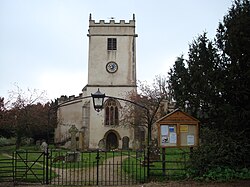Buckland Newton
| Buckland Newton | |
| Dorset | |
|---|---|
 The Church of the Holy Rood, Buckland Newton | |
| Location | |
| Grid reference: | ST692053 |
| Location: | 50°50’47"N, 2°26’24"W |
| Data | |
| Population: | 622 (2011) |
| Post town: | Dorchester |
| Postcode: | DT2 |
| Local Government | |
| Council: | Dorset |
| Parliamentary constituency: |
West Dorset |
Buckland Newton is a village in Dorset, sitting beneath the scarp slope of the Dorset Downs, seven and a half miles south of Sherborne. The 2011 census found a parish population of 622.
The village lies within the Buckland Newton Hundred. The village pub is The Gaggle of Geese. There are also a shop, a primary school and village hall.[1]
Approximately three quarters of the parish lies within the Dorset Area of Outstanding Natural Beauty.
Parish church
The parish church, known as the Church of the Holy Rood has a 13th-century chancel and 15th-century nave, west tower and aisles, plus fragments of 12th-century sculpture which are evidence of an earlier structure.[2] The church underwent a Victorian restoration in the 19th century.
In 1980 the writer and literary director Roland Gant described Holy Rood as "a lovely church", but that the first impression it created was not favourable due to its exterior having been rendered in cement, "giving the Perpendicular square tower the look of a Foreign Legion fort".[3]
The church has six bells, the oldest having been cast around 1380.[4]
History
The name 'Buckland' derives from boc-land, Old English for 'charter land' or land granted by lease or charter, while 'Newton' is a more recent addition taken from Sturminster Newton, a nearby town.[5]
Evidence for prehistoric settlement comes from Bronze Age barrows at Gales Hill and the Iron Age hill fort of Dungeon Hill.[6]
The parish originally had five settlements, each with their own open field system: Buckland Newton, Brockhampton, Duntish, Henley (perhaps previously known as Knoll) and Minterne Parva, the last now part of Minterne Magna parish.[2]
Duntish Court, sited about half a mile north of the main village, was a compact, classical country house built in 1764 beside the main Weymouth to Bath turnpike road. Designed by Sir William Chambers, the Court—originally named Castle Hill—had notable plasterwork, grounds of 1,300.0 acres (526.1 ha) and played a role in the arrest of agricultural labourers in Dorset's 'Captain Swing' riots of 1830. It was demolished in 1965.[7]
Geography
Prominent nearby hills at the top of the escarpment to the southeast include the 820-foot Ball Hill and the 860-foot Lyscombe Hill near the Dorsetshire Gap.
The River Lydden rises in the numerous springs round the village, principally Buckland Bottom and Bladeley Bottom.
There are 11 locally recognised Sites of Nature Conservation Interest within or close to the parish, as well as areas of Ancient Woodland. The main habitat types for sites of wildlife interest are deciduous woodland and calcareous grassland (the latter is particularly significant for butterflies). There is also a small area of lowland meadows within Buckland Newton Itself.
Outside links
| ("Wikimedia Commons" has material about Buckland Newton) |
References
- ↑ Around the Village: BucklandNewton.com
- ↑ 2.0 2.1 Template:Rchme
- ↑ Roland Gant (1980). Dorset Villages. Robert Hale Ltd. p. 72. ISBN 0-7091-8135-3.
- ↑ Dove's Guide for Church Bell Ringers, Central Council of Church Bell Ringers, http://dove.cccbr.org.uk/home.php
- ↑ Mills, Anthony David: 'A Dictionary of British Place-Names' (Oxford University Press, 2003) ISBN 978-0-19-852758-9
- ↑ Buckland Newton: An Inventory of the Historical Monuments in Dorset, Volume 3, pages 48-54
- ↑ Jo Draper (May 2008). "'Leave not a rack behind'". Dorset Life Magazine. http://www.dorsetlife.co.uk/2008/05/leave-not-a-rack-behind/. Retrieved 5 June 2014.
